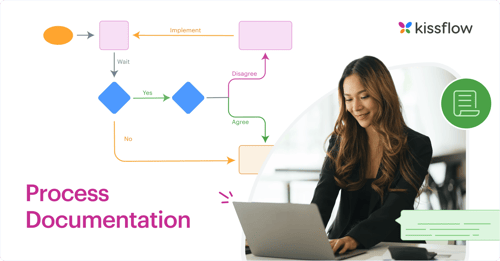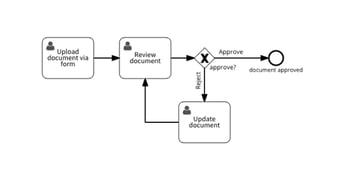Related Articles

Team Kissflow
Updated on 17 Mar 2025 • 4 min read
Where tech meets strategy, CIOs, and BTPs are the rockstars driving efficiency and innovation. They know that process documentation - often forgotten in the hustle - is a secret weapon for businesses of all sizes.
Don't mistake process documentation for just paperwork. It's a powerhouse for boosting efficiency and meeting customer needs in a world where options are a click away. It's the underestimated champion of long-term success.
This guide is custom-made for CIOs and BTPs. It dives into the magic of process documentation, revealing its power to transform your business. From ramping up operations to keeping customers happy, this guide arms tech leaders with the knowledge to make process documentation a strategic priority. Welcome to your competitive edge in the digital world!
Process documentation is an essential discipline of business process management that involves recording a detailed outline of process steps from beginning to end to show how a process is executed. Commonly mapped in a flowchart, it provides a clear, top-down perspective for employees and managers to visualize and understand process workflows.
The goal of process documentation is similar to that of business process management. It improves business performance and operational agility by optimizing core processes. Documenting processes during execution enables employees to learn by doing, gleaning insight from both mistakes and successes to refine processes.

Thank you for downloading!

Regardless of an organization’s size or purpose, process documentation is important. Even if it’s a one-man show, looking to the future when processes and employees will be multiplied is paramount. The lack of documented, standard procedures leads to repeated mistakes and continuing inefficiencies at significant costs to your business.
If the thought of beginning process documentation is daunting, don’t worry, there are plenty of process documentation tools available. The most basic process documentation tool is Microsoft Word, but its clunkiness and sharing capabilities aren’t ideal. Web-based tools make for much simpler collaboration and editing.
You’ll find most process documentation tools can be used for a multitude of organizational tasks, so look for one that meets your specific business needs to get the best value proposition.
Below are the top 3 process documentation tools in 2022:
Designed for any-size business, Lucidchart is a flowchart platform that offers a comprehensive range of features and integrates nicely with popular applications. Business Users with limited technical know-how can create attractive, professional diagrams and fully utilize its extensive functionalities intuitively.
Similar to Lucidchart, SmartDraw is a diagramming software with plenty of templates to help you get started. Because it integrates with a host of apps, chart sharing and collaboration are easily achievable. SmartDraw is known for its user-friendliness and affordable price.
If you are looking for a comprehensive document collaboration solution, Bit.ai combines an endless number of tools on a sleek, modern platform. Rich media can be embedded with its documents for an extra layer of context.
Kissflow is a business process management software for turning workflows into automated actions. Instead of mapping a process in a standalone process documentation tool, repetitive process workflows are simultaneously mapped and automated in Kissflow.
It’s no-code, simple design empowers citizen developers to collect necessary process information in a form. Through a drag-and-drop interface, the workflow is charted, including all steps and stakeholders. Integration and conditions are added, notifications and reminders are set, a trial run is performed, and automation begins.
Process steps travel in sequence according to the charted workflow. Manual document routing and other tedious tasks are eliminated. For example, rather than physically creating file and folders in Google Drive, it is done automatically when a new form is completed.
☛ More on the benefits of ‘Document Workflow Automation‘ here
Real-time analytics let stakeholders know how processes are doing. KPIs, SLAs, and other performance metrics are consistently monitored. Weak areas are improved, strong areas are capitalized, and performance is optimized.
Kissflow Process provides a centralized platform to define and track workflow. Workers can post clarity or rework requests, comments, and shared documents directly in the workflow. The number of apps and users can easily be scaled up or down according to business needs.
Wrapping up, it's clear that process documentation is not just a 'nice-to-have'—it's a business essential. Businesses can benefit immensely from well-structured and maintained process documentation regardless of size or industry. It's a secret weapon that drives efficiency, aligns teams, and meets customer needs swiftly and effectively.
If your business isn’t already suffering from chaotic operations, it’s only a matter of time before process complexity increases and disarray sets in. Process documentation is vital to maintaining a healthy, productive business. Getting a firm handle on your core processes early on can facilitate explosive growth while sustaining excellent service delivery.
CIOs and BTPs have a unique role in championing this aspect, bridging the gap between technology and strategy. With process documentation, they can guide their organizations to navigate the digital landscape competitively.
In the end, process documentation isn't about paperwork but progress, performance, and prosperity. With Kissflow at your side, you're well-equipped to harness the transformative power of process documentation. So, do you need process documentation? The answer is a resounding yes! Embrace it today, and unlock your organization's full potential for tomorrow.
Solve your workflow challenges with Kissflow and optimize your team's productivity.
Related Articles
Welcome.
Let's get started.
To begin, tell us a bit about yourself
By proceeding, you agree to our Terms of Service and Privacy Policy
"The beauty of Kissflow is how quick and easy it is to create the apps I need. It's so user-friendly that I made exactly what I needed in 30 minutes."
Oliver Umehara
IT Manager - SoftBank
A Trusted Choice for Companies Globally




Thank you for signing up
Someone from our team will contact you soon.

Know why all the IT leaders converging at booth #602
Earn a chance to be part of our experience event

Get the first look at the 2024 Citizen Development report
Welcome.
Let's get started.
By proceeding, you agree to our Terms of Service and Privacy Policy
Wondering where to start?
Let's talk!
Connect with our solution experts to gain insights on how Kissflow can help you transform ideas into reality and accelerate digital transformation

This website uses cookies to ensure you get the best experience. Check our Privacy Policy


